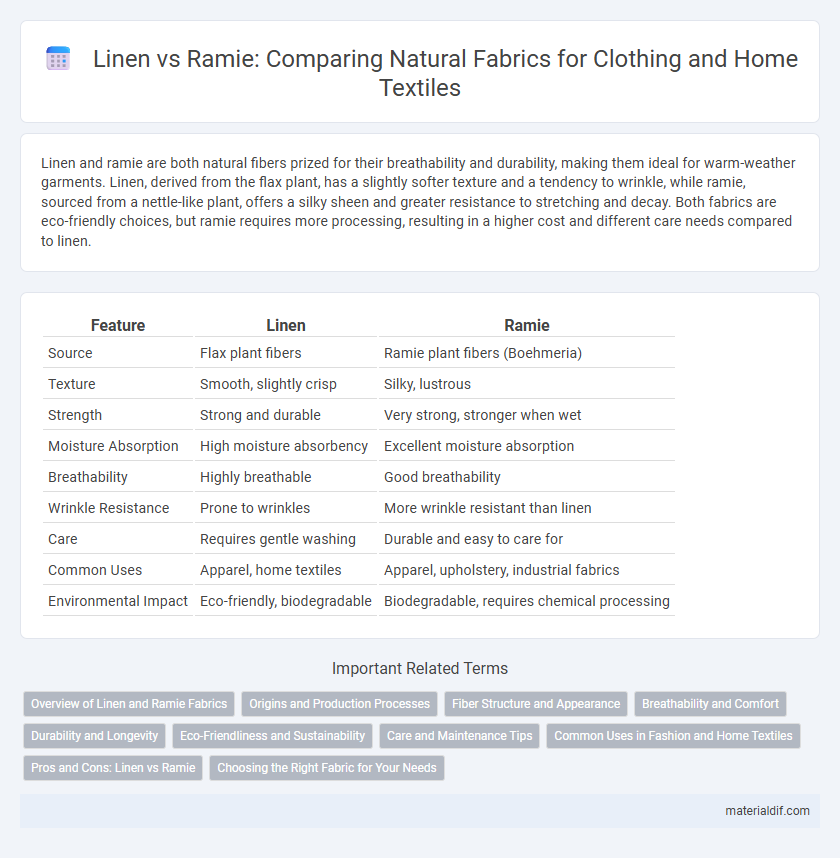Linen and ramie are both natural fibers prized for their breathability and durability, making them ideal for warm-weather garments. Linen, derived from the flax plant, has a slightly softer texture and a tendency to wrinkle, while ramie, sourced from a nettle-like plant, offers a silky sheen and greater resistance to stretching and decay. Both fabrics are eco-friendly choices, but ramie requires more processing, resulting in a higher cost and different care needs compared to linen.
Table of Comparison
| Feature | Linen | Ramie |
|---|---|---|
| Source | Flax plant fibers | Ramie plant fibers (Boehmeria) |
| Texture | Smooth, slightly crisp | Silky, lustrous |
| Strength | Strong and durable | Very strong, stronger when wet |
| Moisture Absorption | High moisture absorbency | Excellent moisture absorption |
| Breathability | Highly breathable | Good breathability |
| Wrinkle Resistance | Prone to wrinkles | More wrinkle resistant than linen |
| Care | Requires gentle washing | Durable and easy to care for |
| Common Uses | Apparel, home textiles | Apparel, upholstery, industrial fabrics |
| Environmental Impact | Eco-friendly, biodegradable | Biodegradable, requires chemical processing |
Overview of Linen and Ramie Fabrics
Linen, derived from the flax plant, is renowned for its strength, moisture-wicking properties, and breathability, making it ideal for warm-weather clothing and home textiles. Ramie, a bast fiber obtained from the Chinese nettle plant, offers exceptional durability, resistance to wrinkles, and a silky luster that enhances fabric aesthetics. Both linen and ramie fibers blend well with cotton and synthetic fibers, improving textile performance and versatility in fashion and upholstery applications.
Origins and Production Processes
Linen originates from the flax plant, primarily cultivated in Europe and parts of Asia, while ramie is derived from the stalks of the Boehmeria plant native to East Asia. The production process of linen involves retting, where the flax stalks are soaked to separate fibers, followed by scutching and hackling to refine them, whereas ramie undergoes degumming to remove gums and pectins that bind the fibers together. Both fabrics require labor-intensive extraction methods, but ramie's degumming process distinguishes its production by yielding a finer, shinier fiber compared to the coarse texture of linen.
Fiber Structure and Appearance
Linen fibers, derived from flax plants, exhibit a natural irregularity with visible nodes and a smooth surface, resulting in a lustrous fabric known for breathability and strength. Ramie fibers feature a finer, silkier texture with fewer visible nodes and a more uniform, glossy appearance due to their higher cellulose content. The distinct fiber structures influence linen's slightly coarser feel compared to ramie's silkier and smoother fabric, affecting drape and sheen in textile applications.
Breathability and Comfort
Linen and ramie both excel in breathability due to their natural fiber structures, allowing air to circulate freely and wick moisture away from the skin. Linen's slightly coarser texture offers a durable yet comfortable feel that softens with wear, while ramie provides a smoother, silk-like finish with excellent moisture absorption, enhancing comfort in hot and humid conditions. Both fabrics are ideal for summer garments, but linen tends to be preferred for its superior breathability and long-term comfort.
Durability and Longevity
Linen, made from flax fibers, is renowned for its exceptional durability and resistance to wear, making it ideal for long-lasting textiles and upholstery. Ramie, derived from the nettle family plant, boasts high tensile strength but tends to be less elastic, which can affect its resilience over time compared to linen. Both fabrics exhibit excellent longevity, yet linen's superior flexibility and moisture-wicking properties enhance its durability for sustained use in garments and home furnishings.
Eco-Friendliness and Sustainability
Linen and ramie are both eco-friendly fabrics derived from natural plant fibers, with linen sourced from flax plants and ramie extracted from the stalks of the Chinese grass plant. Linen production typically requires less water and fewer pesticides compared to cotton, making it highly sustainable, while ramie is valued for its ability to grow quickly with minimal chemical input and can be harvested multiple times annually. Both fibers are biodegradable and durable, reducing environmental impact through longer garment life cycles and lower resource consumption.
Care and Maintenance Tips
Linen requires gentle washing in lukewarm water with mild detergent to maintain its natural fibers and prevent shrinkage, while ramie benefits from hand washing or gentle machine cycles to preserve its strength and texture. Both fabrics should be air-dried and ironed on low heat to avoid damage; ramie may wrinkle more easily but is more resistant to mildew than linen. Avoid bleach and opt for natural, breathable storage conditions to extend the lifespan of these eco-friendly textiles.
Common Uses in Fashion and Home Textiles
Linen and ramie fabrics are widely used in fashion and home textiles for their durability and breathability. Linen is favored for lightweight clothing, summer dresses, and home items like curtains and tablecloths due to its natural luster and moisture-wicking properties. Ramie, valued for its silky texture and strength, is commonly used in blends for suits, upholstery, and decorative fabrics, enhancing resilience and sheen.
Pros and Cons: Linen vs Ramie
Linen offers exceptional breathability and durability, making it ideal for warm climates, but it tends to wrinkle easily and can be more expensive. Ramie is highly resistant to moisture, mildew, and insect damage, providing a lustrous finish and strong fibers, though it may feel stiffer and less soft compared to linen. Both fabrics are eco-friendly, but linen generally offers better moisture absorption, while ramie excels in resistance to microbial attacks.
Choosing the Right Fabric for Your Needs
Linen and ramie both offer strong, breathable natural fibers ideal for warm-weather clothing and home textiles, but linen provides superior softness and moisture-wicking properties, making it more comfortable for direct skin contact. Ramie excels in durability and resistance to pests and mildew, suitable for upholstery or outdoor fabrics where longevity is critical. Choosing between these depends on your priorities: select linen for comfort and luxurious texture, or ramie for robust, long-lasting applications.
Linen vs Ramie Infographic

 materialdif.com
materialdif.com